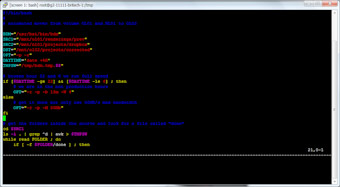Company to Introduce Standalone Versions of Proprietary Software at IBC
Roger Beck: We’ll be showing the BrightDrive Astella, our all-in-one solution. You get storage with an embedded metadata server, and the capability of additional ports so that up to eight clients can connect. You can save around $25,000 by going with Astella instead of buying a full-sized system right away. But you can still grow into one. Let’s say a customer uses Astella for a facility with three or four operators, and business is going so well that he wants to expand. He can turn the Astella into a simple RAID and transfer the software over to the G2, our next higher-capability product, so he doesn’t lose money. Our software and the metadata part would be put on a dedicated server to meet the concurrent performance requirements for more clients. So more hardware is involved, but he doesn’t have to buy two new servers. He can grow without worrying about wasting his money now.
And the Astella debuted at NAB?
Yes. We shipped the first one in May, so a couple of systems are out there right now. We work with DFT in Germany, and they have customers with small set-ups – one film scanner, one Bones Dailies system, and one other application. They don’t need the full infrastructure.
Are smaller, boutique facilities becoming more important to your business?
Well, our vendors have customers who don’t want to buy a $100,000 solution. This is designed for the $50,000-$60,000 price range. Everyone is providing bigger solutions, but not entry-level solutions. It’s the same if you have a complete NAS environment and now want to go real time. You don’t have to buy everything new. You just buy storage, and there’s an additional fee for the fibre channel card and the embedded metadata server.
Tell us about Data Mover and Data Optimizer.
Let’s start with Data Optimizer, which we’ve had for about 10 years, but only for our Bright customers. There are about 7,000 post-production facilities in the world, and we don’t know how many are based on Quantum StorNext, so why not make the tools available to the public? You have different storage environments with different tools. One, a defragmenter, comes with StorNext. Let’s assume you have a fragmented, randomized, and out-of-sequence file system. Defrag will get one file back in shape, but that file can still be randomized or placed on the volume so that every time you seek for the file you lose time. You might get a dropped frame while playing out or ingesting. But our Data Optimizer is sequence-aware. It will optimize every file and put them in the proper order. If you just drag and drop or use a command-line tool, those tools are not sequence aware. So the placement of the files in a sequence is randomized. That means that if you have 10,000 frames, it takes at least 10,000 head-jumps to seek the file for the client application. With Data Optimizer, you bring them in, in sequence, from 1 to 10,000. It buys you performance. It can’t improve the performance of your system, but it can bring the performance of a fresh file system back.
What about Data Mover?
That’s a proactive tool. Randomization and fragmentation occur if you don’t bring the files in correctly in the first place. Data Mover is sequence aware, so it brings the sequence in to the volume without fragmenting or randomizing it. It’s based on StorNext FS and HyperFS, and it’s optimized to be faster than normal copy tools. There is a feature that throttles the bandwidth so that it doesn’t affect the current workflow, or it can go in real time if you need it to. So it communicates with the StorNext layer and lays your files down, in sequence, to the biggest available chunk on your volume.

Data Mover is controllable via scripting from the command line. Click the image for a better look.
It has some stereo 3D support built in too, correct?
Yes. There are some applications out there, such as SpeedGrade, that can handle a stereo 3D stream. We’ve learned that usually the customer has two [storage] volumes, one for the right eye and one for the left eye. So in addition to the problems of fragmentation and randomization, you also have two different volumes playing the stream, which is hard to maintain. We merge those eyes into one volume that’s interleaved for 3D stereo – it’s one stream with 48 frames per second instead of two streams with 24 frames. You get more performance out of your workspace than you would with two streams and it makes data management easier as you work on one volume.
You probably save a little on overhead, too.
If a RAID was capable of handling two [24 fps] streams before, it will be able to handle 48 [fps] and maybe an additional half-stream now. And you have options to throttle it, speed it up, or manage the threads and buffers you want to use. It verifies by default, but you can do additional verification to be sure.
And this works on StorNext and HyperFS?
It’s optimized for fibre-channel StorNext and Hyper FS, but it will probably help you on every file system. We have a customer using NTFS on Windows with two clients and he has to remake his file system every two weeks. We got him a demo version, and he told us it’s a great improvement. So it has an advantage for every file system if you want to be sequence aware.
For more information: www.4bright.com.
Sections: Business Technology
Did you enjoy this article? Sign up to receive the StudioDaily Fix eletter containing the latest stories, including news, videos, interviews, reviews and more.